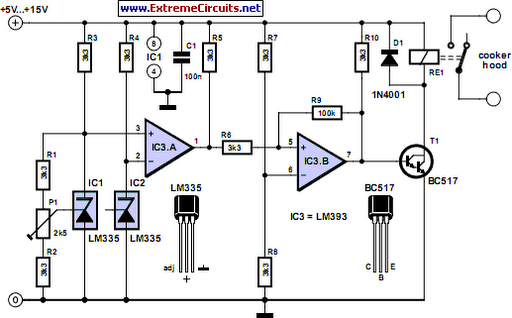Home » Circuits
Automatic Range Hood
Come to think about it, it’s a bit strange that range hoods in our kitchens don’t switch on and off automatically. After all, a simple temperature sensor under the hood can detect whether a burner is on. The circuit described here goes a step further and compares the temperature under the hood with the temperature just outside the hood. At a certain (adjustable) temperature difference, the hood will be switched on, possibly along with the lamp under the hood.After the burners are shut off, the hood fan and lamp will switch off again by themselves. The advantage of using two sensors is that the hood will have the same switching characteristics in the summer as in the winter. When building the circuit, it’s important to ensure that IC1 is located beneath the hood in the middle and IC2 is located next to the hood or above it. If the temperature under the hood is higher than the temperature outside it, the open-collector output of IC3 will be pulled up to the supply voltage by R6.
Circuit diagram:
The combination of IC3 and R7–R10 forms a Schmitt trigger, which we need because the output of IC3a does not change immediately from 0V to the supply voltage (or vice versa) in the transition region. The output of the IC3b will thus be at the supply voltage, which will switch on T1 via R10. That causes the relay to engage and switch on the fan and lamp of the range hood. P1 can be used to adjust the output voltage of IC1 over a range of approximately 0.1 V, which corresponds to around 10 °C.
It’s a good idea to use a supply voltage that matches the operating voltage of the relay. It’s also convenient to fit the relay in a small box with an electrical outlet and plug so it can be easily and safely inserted between the plug and outlet of the range hood. The circuit works best with a gas cooker, because the heat rises immediately after a burner is lit. With a ceramic or inductive cooking top, it takes a bit longer for the relay to be actuated.
Author: Heino Peters
Copyright: Elektor Electronics
Copyright: Elektor Electronics

